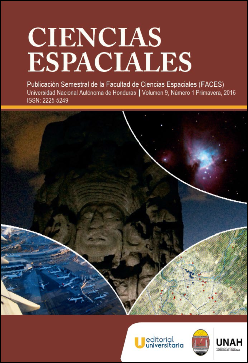Assessment of the probability of impact of the Earth with the Asteroid 2011 AG5
DOI:
https://doi.org/10.5377/ce.v9i1.3125Keywords:
2011AG5, Near Earth Asteroid (NEA), Potentially Hazardous Asteroids (PHA), close approach in 2040, Apollo asteroidAbstract
The NEA 2011AG5 object is an asteroid 140 meters in diameter, discovered on Jan. 8, 2011 from Mount Lemmon in the United States. It has an orbit that makes it a potentially hazardous asteroid, an object whose minimum distance to Earth’s orbit is 0.05AU. Due to its orbital characteristics, it is an Apollo object, which means it is an asteroid that crosses the orbit of Earth having a perihelion smaller than 1.0167AU. The orbital motion of the object NEA 2011AG5 has been modeled for a period of approximately 28 years, from 2012 until 2040 using the numerical integrator EVORB, a program based on FORTRAN architecture to model the dynamics of objects in a stellar system. It has been developed 100 samples based on the orbital parameters estimated up to 18 April 2013. After ensuring that the random orbital parameters conform a normal distribution, due to its Jarque Bera is less than 5,991 for α = 0.05, it was estimated that the closest approach will occur on February 4, 2040. An average distance of 1,087,412 km is estimated with a standard deviation of 46.637 Km, in a calculated approach likely for February 4, 2040 at 8h37m universal time, with a standard deviation of 48m04s. The probability of impact is null.
Downloads
1179




